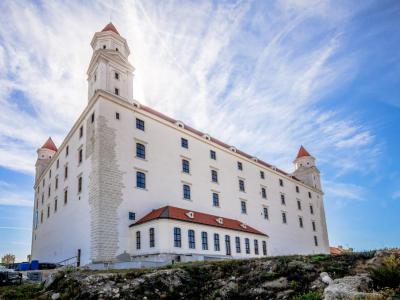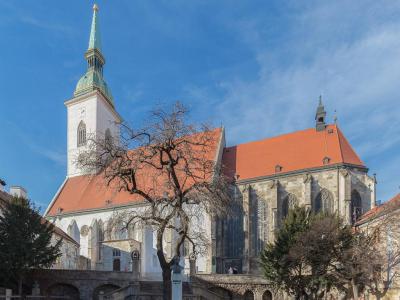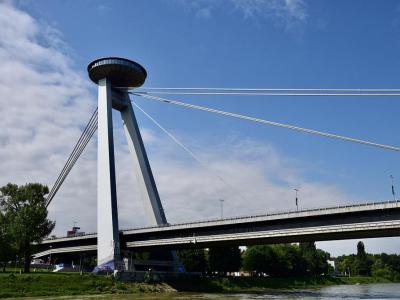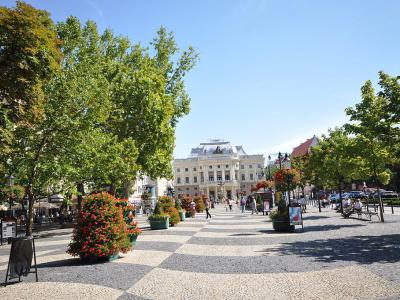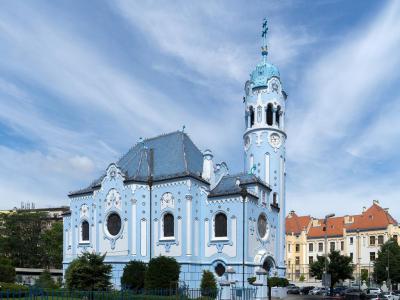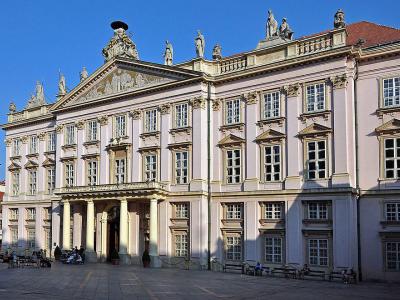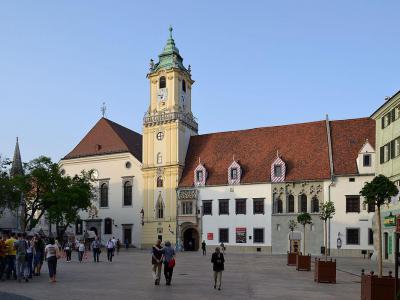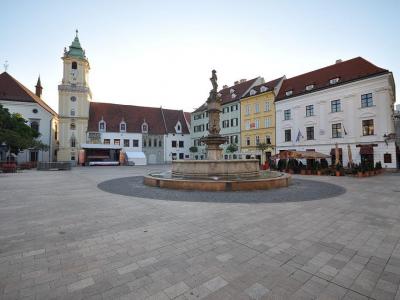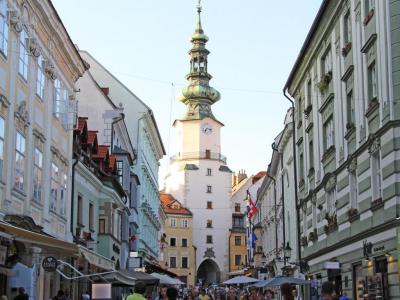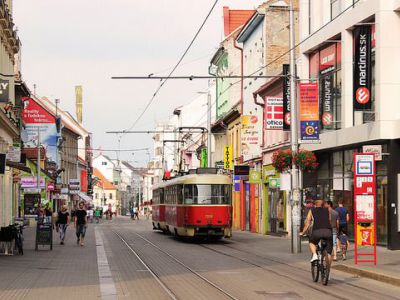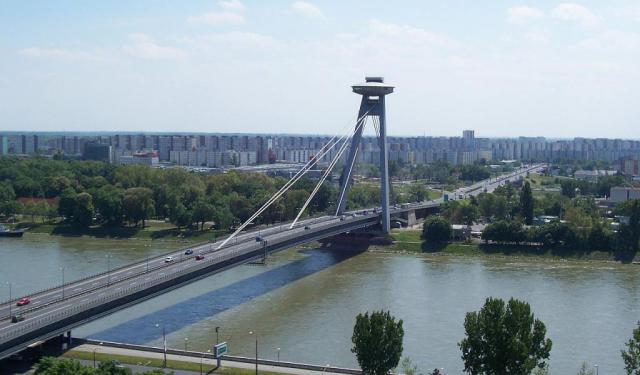Bratislava Introduction Walking Tour (Self Guided), Bratislava
The capital of Slovakia, Bratislava, is a lovely city straddling the river Danube near the convergence of the Austrian and Hungarian borders. Such closeness had its toll on the city's long and often tumultuous history, in which the Austrians, Croats, Czechs, Germans, Hungarians, Jews, Serbs and Slovaks played their role.
Formerly part of the Hungarian Kingdom, from 1536 to 1783 it was the country's legislative center and capital, with multiple kings and queens of Hungary crowned in the local St. Martin's Cathedral.
For centuries, the city went by the German name Pressburg, since after 1526 it was dominated mostly by the Habsburg Monarchy and ethnic-German population. The modern name Bratislava is credited to the misinterpretation of Braslav (the medieval settlement predating the city) in the historical analysis of medieval sources, which led to the invention of the term Bratislav. Initially used only by some Slovak patriots, it became official in March 1919.
Pressburg flourished throughout the 18th-century reign of Queen Maria Theresa, becoming the largest and most important town in Hungary, and the center of its social and cultural life. The 19th century brought here great industrial development. After WWI and the formation of Czechoslovakia in 1918, the city was incorporated, albeit somewhat reluctantly, into the new state.
After the Communist takeover of Czechoslovakia in 1948, the city became part of the Eastern Bloc; and shortly after the failed Czechoslovak attempt to liberalize the Communist rule in 1968 – the capital of the Slovak Socialist Republic. In 1993, following the Velvet Divorce, Bratislava became the capital of the newly established independent Slovak Republic.
Renowned for its attractions, Bratislava receives annually around 1 million tourists. Its pedestrian-only, 18th-century Old Town is dominated by Bratislava Castle – the city's most conspicuous landmark, perched atop a hill over the Danube. Another iconic sight is the New Bridge with the UFO Observation Deck, built in 1967-1972. The city's Hviezdoslav Square is a beautiful place to walk around, filled with memorials to national figures and lots of history.
Also notable, from an architectural standpoint, is the Blue Church, clad in the Hungarian-made Zsolnay tiles. The home base of the City Mayor – Primate's Palace – is an impressive 18th-century Baroque sight; while the Old Town Hall is an excellent example of Gothic architecture from the 1300s.
Take this walk to visit some of the most prominent sights of the historic Slovakian capital.
Formerly part of the Hungarian Kingdom, from 1536 to 1783 it was the country's legislative center and capital, with multiple kings and queens of Hungary crowned in the local St. Martin's Cathedral.
For centuries, the city went by the German name Pressburg, since after 1526 it was dominated mostly by the Habsburg Monarchy and ethnic-German population. The modern name Bratislava is credited to the misinterpretation of Braslav (the medieval settlement predating the city) in the historical analysis of medieval sources, which led to the invention of the term Bratislav. Initially used only by some Slovak patriots, it became official in March 1919.
Pressburg flourished throughout the 18th-century reign of Queen Maria Theresa, becoming the largest and most important town in Hungary, and the center of its social and cultural life. The 19th century brought here great industrial development. After WWI and the formation of Czechoslovakia in 1918, the city was incorporated, albeit somewhat reluctantly, into the new state.
After the Communist takeover of Czechoslovakia in 1948, the city became part of the Eastern Bloc; and shortly after the failed Czechoslovak attempt to liberalize the Communist rule in 1968 – the capital of the Slovak Socialist Republic. In 1993, following the Velvet Divorce, Bratislava became the capital of the newly established independent Slovak Republic.
Renowned for its attractions, Bratislava receives annually around 1 million tourists. Its pedestrian-only, 18th-century Old Town is dominated by Bratislava Castle – the city's most conspicuous landmark, perched atop a hill over the Danube. Another iconic sight is the New Bridge with the UFO Observation Deck, built in 1967-1972. The city's Hviezdoslav Square is a beautiful place to walk around, filled with memorials to national figures and lots of history.
Also notable, from an architectural standpoint, is the Blue Church, clad in the Hungarian-made Zsolnay tiles. The home base of the City Mayor – Primate's Palace – is an impressive 18th-century Baroque sight; while the Old Town Hall is an excellent example of Gothic architecture from the 1300s.
Take this walk to visit some of the most prominent sights of the historic Slovakian capital.
How it works: Download the app "GPSmyCity: Walks in 1K+ Cities" from Apple App Store or Google Play Store to your mobile phone or tablet. The app turns your mobile device into a personal tour guide and its built-in GPS navigation functions guide you from one tour stop to next. The app works offline, so no data plan is needed when traveling abroad.
Bratislava Introduction Walking Tour Map
Guide Name: Bratislava Introduction Walking Tour
Guide Location: Slovakia » Bratislava (See other walking tours in Bratislava)
Guide Type: Self-guided Walking Tour (Sightseeing)
# of Attractions: 10
Tour Duration: 2 Hour(s)
Travel Distance: 3.4 Km or 2.1 Miles
Author: hollyg
Sight(s) Featured in This Guide:
Guide Location: Slovakia » Bratislava (See other walking tours in Bratislava)
Guide Type: Self-guided Walking Tour (Sightseeing)
# of Attractions: 10
Tour Duration: 2 Hour(s)
Travel Distance: 3.4 Km or 2.1 Miles
Author: hollyg
Sight(s) Featured in This Guide:
- Bratislava Castle
- St. Martin's Cathedral
- New Bridge and UFO Observation Deck
- Hviezdoslav Square
- Blue Church
- Primate's Palace
- Old Town Hall
- Hlavne Namestie (Main Square)
- Michael's Tower and Street
- Obchodna Street
1) Bratislava Castle (must see)
The imposing Bratislava Castle is the most conspicuous landmark in the town of Bratislava. It stands on an isolated rocky hill above the town, and had been built and rebuilt continuously throughout the 9th-18th centuries.
The site of the castle has been of strategic importance for most of the area's history. It is located roughly in the center of Europe. Still, more importantly, it is along the route between the Carpathians and the Alps at a convenient crossing point of the river Danube.
The hill and surrounding area have hosted settlements since before the early Iron Age. Evidence suggests that the first settlements here started around 3,500 BC. In those early centuries, the hill was used as an acropolis for the surrounding town.
Archeological evidence shows a history of Celt and Roman occupation through 500 AD. The current structure was begun in the 10th century but worked lagged over the years. As the need for defense increased for the Kingdom of Hungary, the castle was added on to.
The Kingdom was abolished in 1781, and the castle was more or less dismantled and abandoned. The structures were used as a seminary and military barracks for some time during the 19th century. By the middle part of the 20th century, the castle was in ruins.
A massive restoration effort was begun in 1957 and completed in 1968. The 1968 Federation Law, which formed the Czech Socialist Republic and the Slovak Socialist Republic, was signed in the castle. Many years later, the constitution of now independent Slovakia was also signed in the castle's Knights Hall.
The castle is beautifully restored and houses exhibitions from the Slovak National Museum. Even if you choose not to visit the museum and interior rooms, walking around the castle grounds and enjoying the views of the city and the Danube is not to be missed.
The site of the castle has been of strategic importance for most of the area's history. It is located roughly in the center of Europe. Still, more importantly, it is along the route between the Carpathians and the Alps at a convenient crossing point of the river Danube.
The hill and surrounding area have hosted settlements since before the early Iron Age. Evidence suggests that the first settlements here started around 3,500 BC. In those early centuries, the hill was used as an acropolis for the surrounding town.
Archeological evidence shows a history of Celt and Roman occupation through 500 AD. The current structure was begun in the 10th century but worked lagged over the years. As the need for defense increased for the Kingdom of Hungary, the castle was added on to.
The Kingdom was abolished in 1781, and the castle was more or less dismantled and abandoned. The structures were used as a seminary and military barracks for some time during the 19th century. By the middle part of the 20th century, the castle was in ruins.
A massive restoration effort was begun in 1957 and completed in 1968. The 1968 Federation Law, which formed the Czech Socialist Republic and the Slovak Socialist Republic, was signed in the castle. Many years later, the constitution of now independent Slovakia was also signed in the castle's Knights Hall.
The castle is beautifully restored and houses exhibitions from the Slovak National Museum. Even if you choose not to visit the museum and interior rooms, walking around the castle grounds and enjoying the views of the city and the Danube is not to be missed.
2) St. Martin's Cathedral (must see)
In the town's early history, worshipping was done at the Bratislava Castle. But in the early 13th century, the King of Hungary requested that the pope allow him to relocate the church. So, as the town grew, the construction of a Gothic cathedral began in 1311.
It wasn't completed until 1452 due to financial difficulties and the Hussite Wars. Additions were made in the 18th and 19th centuries, including the Baroque Chapel of Saint John the Merciful.
The present appearance of the building has been steady since 1877 when significant restoration efforts were completed after earthquakes, fires, and war had damaged the cathedral.
The cathedral is most famous as the coronation church for the Kingdom of Hungary from 1563 onward. Eleven kings and queens and eight of their consorts were coronated in the building.
In recognition of this honor, the cathedral tower is topped with a replica of the Crown of Saint Stephen. This replica of the Holy Crown of Hungary weighs 330 pounds (150 kilograms) and is gold-plated.
The cathedral was built over a cemetery and lay atop an unknown amount of catacombs and crypts. The building is designated a national cultural monument, but it is, unfortunately, decaying due to vibrations from the traffic passing on the Novy Most bridge.
It wasn't completed until 1452 due to financial difficulties and the Hussite Wars. Additions were made in the 18th and 19th centuries, including the Baroque Chapel of Saint John the Merciful.
The present appearance of the building has been steady since 1877 when significant restoration efforts were completed after earthquakes, fires, and war had damaged the cathedral.
The cathedral is most famous as the coronation church for the Kingdom of Hungary from 1563 onward. Eleven kings and queens and eight of their consorts were coronated in the building.
In recognition of this honor, the cathedral tower is topped with a replica of the Crown of Saint Stephen. This replica of the Holy Crown of Hungary weighs 330 pounds (150 kilograms) and is gold-plated.
The cathedral was built over a cemetery and lay atop an unknown amount of catacombs and crypts. The building is designated a national cultural monument, but it is, unfortunately, decaying due to vibrations from the traffic passing on the Novy Most bridge.
3) New Bridge and UFO Observation Deck (must see)
One of the most iconic features of modern-day Bratislava is the Novy Most, or "New Bridge." This modern thoroughfare connects the two halves of the city separated by the river Danube. Since 2012, the official name of the bridge was changed to "Bridge of the Slovak National Uprising" to commemorate the Slovak National Uprising against Nazi during World War II, but locals prefer to call it "UFO Bridge" for its UFO-shaped observation desk at the top.
The Novy Most was built between 1967 and 1972. The total length of the bridge is 1,413 feet or 430 meters. It is an asymmetrical cable-stayed bridge made of steel. It is the world's longest bridge that has only one pylon with one cable-stayed plane. One of the best features of the bridge is that the lower levels are reserved for pedestrian and bicycle traffic only.
Of course, the most notable feature of the Novy Most is the UFO-shaped restaurant and observation deck. The building is mounted on top of the bridge's 278-foot-tall (84.6-meter) pylon.
While the restaurant serves some delicious Slovak and international cuisine, the real lure of the UFO is the view of the city and river from above.
The Novy Most was built between 1967 and 1972. The total length of the bridge is 1,413 feet or 430 meters. It is an asymmetrical cable-stayed bridge made of steel. It is the world's longest bridge that has only one pylon with one cable-stayed plane. One of the best features of the bridge is that the lower levels are reserved for pedestrian and bicycle traffic only.
Of course, the most notable feature of the Novy Most is the UFO-shaped restaurant and observation deck. The building is mounted on top of the bridge's 278-foot-tall (84.6-meter) pylon.
While the restaurant serves some delicious Slovak and international cuisine, the real lure of the UFO is the view of the city and river from above.
4) Hviezdoslav Square
As with most towns in Europe, Bratislava centers around large squares like the Hviezdoslav Square. It's a beautiful place to walk around, with memorials to national figures and lots of history. The square has been here and part of the Kingdom of Hungary for over 1,000 years.
Historically, the square has been the center of daily life and home to many important institutions. For example, the Cathedrale Notre Dame Cloister and the Slovak National Theater were located here. During medieval times, many of the noble families lived near here.
One of the most impressive monuments is to the square's namesake, Pavol Orszagh Hviezdoslav. He was born in 1849, and Hviezdoslav was a famous Slovak poet, dramatist, and Hungarian patriot. He was from a noble family and served in the Czechoslovak parliament from 1918 to 1920.
The square was recently renovated. Whereas it has historically looked like a small park, today's Hviezdoslav Square looks like the impressive city promenade that it is. It is primarily pedestrian-only, with many trees and quiet greenspaces.
Today, you'll find many important businesses and buildings here. The national opera house still stands here. The German and American embassy buildings are on the square, along with several popular hotels. On the north end of the square, you can find many popular restaurants and bars.
Historically, the square has been the center of daily life and home to many important institutions. For example, the Cathedrale Notre Dame Cloister and the Slovak National Theater were located here. During medieval times, many of the noble families lived near here.
One of the most impressive monuments is to the square's namesake, Pavol Orszagh Hviezdoslav. He was born in 1849, and Hviezdoslav was a famous Slovak poet, dramatist, and Hungarian patriot. He was from a noble family and served in the Czechoslovak parliament from 1918 to 1920.
The square was recently renovated. Whereas it has historically looked like a small park, today's Hviezdoslav Square looks like the impressive city promenade that it is. It is primarily pedestrian-only, with many trees and quiet greenspaces.
Today, you'll find many important businesses and buildings here. The national opera house still stands here. The German and American embassy buildings are on the square, along with several popular hotels. On the north end of the square, you can find many popular restaurants and bars.
5) Blue Church (must see)
The Hungarian Secessionist Catholic Church, known as the Church of Saint Elisabeth or the Blue Church, is located in Old Town Bratislava. The construction was consecrated to Elisabeth of Hungary, who was a princess and, later, became a Roman Catholic saint. She was widowed young and surrendered her wealth for a life devoted to the poor and indigent. After her death at the age of 24, many miracles of healing were accredited to her. She was canonized by Pope Gregory IX in 1235.
Built in 1908, the structure was designed by Odon Lechner, a recognized Hungarian architect. He was known to embellish his constructions with Zsolnay tile patterns. Zsolnay tiles were manufactured by a Hungarian company known for its intricate porcelain, tiles, stoneware and pottery. The tiles on the church’s roof were generated using the pyrogranite process, which involves firing ceramic under exceptionally high temperatures, producing resilient materials which are resistant to acid and frost. The structure has attained its name because of the blue color of the mosaics, which decorate its roof and walls.
The building features a cylindrical tower and bell dome common to the Hungarian Art Nouveau and the Romanesque movement in art and architecture. The single nave church contains vaulted ceilings along with hints of barrel vaults. Romanesque double pillars encompass the entrances and the windows.
Built in 1908, the structure was designed by Odon Lechner, a recognized Hungarian architect. He was known to embellish his constructions with Zsolnay tile patterns. Zsolnay tiles were manufactured by a Hungarian company known for its intricate porcelain, tiles, stoneware and pottery. The tiles on the church’s roof were generated using the pyrogranite process, which involves firing ceramic under exceptionally high temperatures, producing resilient materials which are resistant to acid and frost. The structure has attained its name because of the blue color of the mosaics, which decorate its roof and walls.
The building features a cylindrical tower and bell dome common to the Hungarian Art Nouveau and the Romanesque movement in art and architecture. The single nave church contains vaulted ceilings along with hints of barrel vaults. Romanesque double pillars encompass the entrances and the windows.
6) Primate's Palace
Today this impressive baroque building is the home of the Mayor of Bratislava, but there is much more history to uncover here.
The Primate's Palace was built from 1777 to 1781 and was designed by Melchoir Hefele. At one time, the palace was home to the primary bishops.
The palace's greatest claim to fame was that it served as a backdrop for signing the fourth Peace of Pressburg in 1805. This document, signed in the building's famous Hall of Mirrors, dissolved the Holy Roman Empire. A bust of Emperor Francis II, the last Roman Emperor, stands near the hall to commemorate the event.
The city purchased the palace in 1903 and began an extensive reconstruction project. During the work, 17th-century tapestries were found behind walls.
For a brief time, the palace was home to the President of Slovakia before his permanent residence was built at Grassalkovich Palace.
The palace is open for tours. You can even see the famous Hall of Mirrors, now used for Bratislava City Council meetings.
The Primate's Palace was built from 1777 to 1781 and was designed by Melchoir Hefele. At one time, the palace was home to the primary bishops.
The palace's greatest claim to fame was that it served as a backdrop for signing the fourth Peace of Pressburg in 1805. This document, signed in the building's famous Hall of Mirrors, dissolved the Holy Roman Empire. A bust of Emperor Francis II, the last Roman Emperor, stands near the hall to commemorate the event.
The city purchased the palace in 1903 and began an extensive reconstruction project. During the work, 17th-century tapestries were found behind walls.
For a brief time, the palace was home to the President of Slovakia before his permanent residence was built at Grassalkovich Palace.
The palace is open for tours. You can even see the famous Hall of Mirrors, now used for Bratislava City Council meetings.
7) Old Town Hall
The Old Town Hall of Bratislava is an excellent example of Gothic architecture. Originally constructed in the 14th century, with the tower dating back from approximately 1370, this is one of the oldest stone buildings in the Slovakian capital. It was originally designed to accommodate soldiers guarding the fortress surrounding the medieval town.
Presently, the Old Town Hall represents a complex of buildings created through merger of several adjacent townhouses, namely: Jacobus' house with a tower, Pawer's house, Unger's house, and the Apponyi palace. Over the ages, the property had undergone numerous reconstructions and served different purposes: as a prison, mint, market, municipal archive, and arsenal depository, until it finally became a town hall in the 15th century. In this capacity it had served until the late 19th century.
During the Renaissance period, the complex passed through various transformations, including those after being damaged by an earthquake and then fire.
Today, it houses the Bratislava City Museum, featuring a collection of historic artifacts: cannonballs; dungeons with instruments of torture; antique weaponry and armour; as well as paintings and miniatures. One of the cannonballs, the one embedded in the tower wall, is of a particular interest to visitors. It has been there since 1809, resulted from the bombardment of the city by the invading Napoleonic army.
In the summer, the courtyard plays host to musical concerts. In the attic of the Apponyi Palace there is a Study Depository of Glass and Ceramics. The beautifully-tiled roof of the building is one of the city's most recognizable landmarks. The top of the Old Town Hall tower is open to visitors, as part of the Bratislava City Museum exhibition, offering a round view of the old part of Bratislava and its environs.
Presently, the Old Town Hall represents a complex of buildings created through merger of several adjacent townhouses, namely: Jacobus' house with a tower, Pawer's house, Unger's house, and the Apponyi palace. Over the ages, the property had undergone numerous reconstructions and served different purposes: as a prison, mint, market, municipal archive, and arsenal depository, until it finally became a town hall in the 15th century. In this capacity it had served until the late 19th century.
During the Renaissance period, the complex passed through various transformations, including those after being damaged by an earthquake and then fire.
Today, it houses the Bratislava City Museum, featuring a collection of historic artifacts: cannonballs; dungeons with instruments of torture; antique weaponry and armour; as well as paintings and miniatures. One of the cannonballs, the one embedded in the tower wall, is of a particular interest to visitors. It has been there since 1809, resulted from the bombardment of the city by the invading Napoleonic army.
In the summer, the courtyard plays host to musical concerts. In the attic of the Apponyi Palace there is a Study Depository of Glass and Ceramics. The beautifully-tiled roof of the building is one of the city's most recognizable landmarks. The top of the Old Town Hall tower is open to visitors, as part of the Bratislava City Museum exhibition, offering a round view of the old part of Bratislava and its environs.
8) Hlavne Namestie (Main Square) (must see)
The central point in old town Bratislava, the Main Square, has been the hub of the town for centuries. It is surrounded by landmarks, including Kutscherfeldov Palace, Pawera House, Ungerov Dom, and the Maximillian Fountain. Additionally, tons of restaurants, cafes, and bars in the area keep it bustling.
During the winter months, the Main Square is home to Bratislava's Christmas fair. The entire area is decorated, and vendors set up stalls throughout the square. You'll find souvenirs, boiled wine, beer, and many different Slovak foods.
Over the years, the square has changed names several times. During World War II, it was named to honor Hilter. From 1948 to 1989, it was named for the day Bratislava was liberated by the Red Army - 4 April Square.
The square is home to the Old Town Hall building and several other landmark buildings. Old Town Hall was built in 1599 and is the oldest in the country. Today, it houses a museum all about the town's history.
The Japanese and French Embassy are also located here.
During the winter months, the Main Square is home to Bratislava's Christmas fair. The entire area is decorated, and vendors set up stalls throughout the square. You'll find souvenirs, boiled wine, beer, and many different Slovak foods.
Over the years, the square has changed names several times. During World War II, it was named to honor Hilter. From 1948 to 1989, it was named for the day Bratislava was liberated by the Red Army - 4 April Square.
The square is home to the Old Town Hall building and several other landmark buildings. Old Town Hall was built in 1599 and is the oldest in the country. Today, it houses a museum all about the town's history.
The Japanese and French Embassy are also located here.
9) Michael's Tower and Street (must see)
The only surviving gate from the city's medieval walls lies at the end of Michael's Street. Michael's Gate (Michalska Brana) was built around 1300 and once stood with three others leading into town. It is one of the oldest buildings in town.
The tower's baroque exterior is a result of reconstruction works carried out in the 1750s. The statue of Saint Michael and the Dragon was placed at the top during this time.
The gate got its name as the Church of Saint Michael stood just outside the city walls here.
At one point, the city was surrounded by medieval fortifications. Entrance to town was only possible through the four gates, all of which were guarded and fortified. The other gates, now demolished, were the Laurens Gate, Fisherman's Gate on the river Danube, and Vydrica Gate.
At its height, the gate was part of a much larger system of fortifications. They included two rings of city walls, two bastions, a barbican, and a bridge over a moat. The barbican is still present and today has been built into houses. The original bridge over the moat was replaced by a stone one in 1727. Some of the moat is also still visible.
The view from the top of the seven-floor, 51-meter tall tower is spectacular. There is no better place from which to view the old town of Bratislava. To get in the tower, enter through the Museum of Arms. The museum contains excellent exhibits about the fortifications and the history of the city.
The street leading from the Michael's Gate, Michael's Street, is lined with shops and attractions. In addition to the Arms Museum, you'll also find the Pharmacy Museum nearby in a very old shop building. There are also bars, cafes, and restaurants lining the street.
The tower's baroque exterior is a result of reconstruction works carried out in the 1750s. The statue of Saint Michael and the Dragon was placed at the top during this time.
The gate got its name as the Church of Saint Michael stood just outside the city walls here.
At one point, the city was surrounded by medieval fortifications. Entrance to town was only possible through the four gates, all of which were guarded and fortified. The other gates, now demolished, were the Laurens Gate, Fisherman's Gate on the river Danube, and Vydrica Gate.
At its height, the gate was part of a much larger system of fortifications. They included two rings of city walls, two bastions, a barbican, and a bridge over a moat. The barbican is still present and today has been built into houses. The original bridge over the moat was replaced by a stone one in 1727. Some of the moat is also still visible.
The view from the top of the seven-floor, 51-meter tall tower is spectacular. There is no better place from which to view the old town of Bratislava. To get in the tower, enter through the Museum of Arms. The museum contains excellent exhibits about the fortifications and the history of the city.
The street leading from the Michael's Gate, Michael's Street, is lined with shops and attractions. In addition to the Arms Museum, you'll also find the Pharmacy Museum nearby in a very old shop building. There are also bars, cafes, and restaurants lining the street.
10) Obchodna Street
Only a five-minute walk from the pretty Old Town, Obchodná Street is the complete opposite of the latter. The main shopping artery of Bratislava and one of its busiest thoroughfares, it stretches for about 1 kilometer from Saint Michael's Tower in the north to Kollárovo Square in the south, intersecting en route with another popular, pedestrian zone, called Post Street. Also stemming from it is the cute sidestreet, named Vysoka, with a number of lovely restaurants.
Initially, back in the 18th century, the street was known as Schöndorfs, after the Schöndorf suburb that used to be located nearby and had a number of vineyards. Many of the oldest local buildings still date from that period. The area grew popular after WWI, when a large number of merchants and craftsmen came here to set up their businesses. During the Communist era, Obchodna emerged as the booming commercial center.
Nowadays, buzzing with shoppers during the day, although most shops here are not of the classiest kind, Obchodna also offers vibrant nightlife, albeit with a somewhat teenage focus. In the evening, it is routinely flooded with people seeking to have a drink or two at one of the numerous local pubs, bars and restaurants. The abundance of watering holes has given this street a bit of a reputation as boisterous.
Still, taking a stroll here is a must for every shopaholic or people-watcher. Grubby but energetic, dotted with ethnic shops and restaurants, it is most definitely well worth a visit, if you're in the area.
Initially, back in the 18th century, the street was known as Schöndorfs, after the Schöndorf suburb that used to be located nearby and had a number of vineyards. Many of the oldest local buildings still date from that period. The area grew popular after WWI, when a large number of merchants and craftsmen came here to set up their businesses. During the Communist era, Obchodna emerged as the booming commercial center.
Nowadays, buzzing with shoppers during the day, although most shops here are not of the classiest kind, Obchodna also offers vibrant nightlife, albeit with a somewhat teenage focus. In the evening, it is routinely flooded with people seeking to have a drink or two at one of the numerous local pubs, bars and restaurants. The abundance of watering holes has given this street a bit of a reputation as boisterous.
Still, taking a stroll here is a must for every shopaholic or people-watcher. Grubby but energetic, dotted with ethnic shops and restaurants, it is most definitely well worth a visit, if you're in the area.
Walking Tours in Bratislava, Slovakia
Create Your Own Walk in Bratislava
Creating your own self-guided walk in Bratislava is easy and fun. Choose the city attractions that you want to see and a walk route map will be created just for you. You can even set your hotel as the start point of the walk.
Historical Churches
Although somewhat modest in terms of sights, compared to the neighboring Vienna or Prague, the capital of Slovakia, Bratislava, does have a collection of historical churches that may be of interest to lovers of religious architecture.
Perhaps one of the most prominent landmarks in this area is Saint Martin's Cathedral. Dating back to the mid-15th century, this Gothic-style temple with a... view more
Tour Duration: 2 Hour(s)
Travel Distance: 2.5 Km or 1.6 Miles
Perhaps one of the most prominent landmarks in this area is Saint Martin's Cathedral. Dating back to the mid-15th century, this Gothic-style temple with a... view more
Tour Duration: 2 Hour(s)
Travel Distance: 2.5 Km or 1.6 Miles
Bratislava Architectural Jewels
For centuries, Bratislava has been influenced by European art, culture, and architecture. The juxtaposition of styles here creates a captivating fabric where centuries-old Gothic and Baroque structures harmonize with sleek, modern designs.
The majestic Bratislava Castle, perched on a hill overlooking the Danube River since the 9th century, has seen many renovations over the years. Today, it... view more
Tour Duration: 2 Hour(s)
Travel Distance: 3.5 Km or 2.2 Miles
The majestic Bratislava Castle, perched on a hill overlooking the Danube River since the 9th century, has seen many renovations over the years. Today, it... view more
Tour Duration: 2 Hour(s)
Travel Distance: 3.5 Km or 2.2 Miles
Bratislava Old Town
The cityscape of Bratislava is characterized by medieval and other ancient buildings, the lion's share of which are concentrated in the Old Town. The special charm of the city's old quarter never ceases to amaze and is bound to leave anyone absolutely dazzled with its beauty.
The Old Town is indeed Bratislava's historic center, and as such, houses many historic monuments and... view more
Tour Duration: 2 Hour(s)
Travel Distance: 1.2 Km or 0.7 Miles
The Old Town is indeed Bratislava's historic center, and as such, houses many historic monuments and... view more
Tour Duration: 2 Hour(s)
Travel Distance: 1.2 Km or 0.7 Miles
The Most Popular Cities
/ view all



